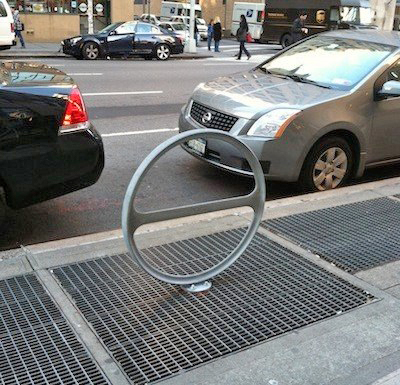This is the first post generated by the Neighborhood Empowerment Project, an initiative of our parent company, Open Plans, to change the ineffective way our city government responds to neighborhood problems. If you have a maddening story of dealing with the city, such as small changes taking years or simply being unable to find an agency that will take responsibility for a problem, submit your story here.
Quick! What's the biggest factor preventing New Yorkers from taking up bicycle commuting?
If your answer is some variation of "safety," congratulations. According to The New York City Bicycle Survey conducted by the Bloomberg administration in 2006, people who did not bike to work were asked what was holding them back. "Too much traffic/driver behavior" had a higher average ranking among non-commuters than any other response.
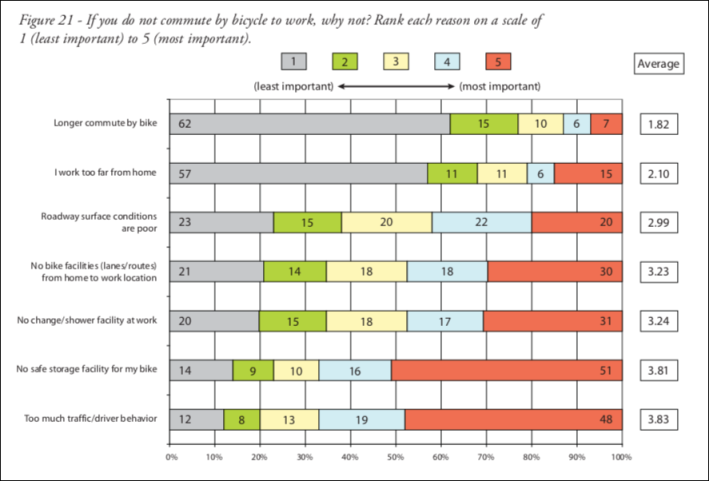
But close behind it was something rather simple: a lack of secure parking. Interestingly, while it had a slightly lower average score than safety concerns, "No safe storage facility for my bike" was ranked by more people overall as the most important factor influencing their decision to not commute to work by bicycle.
Since this survey was released, both the public and private sectors have taken great strides to provide New Yorkers with secure places to park bicycles during working hours. From the ongoing evolution of the city's "Bikes in Buildings" laws to efforts by commercial property owners to provide bike rooms for their tenants, the options available to people who pedal to work grow each year. (And that's not including Citi Bike, which counts among its top benefits the elimination of concerns about bike storage at the end of a trip.)
Unfortunately, there's piece of the bike parking puzzle where New York City isn't keeping up. And that's the humble bicycle rack. According to a report in amNY by Vincent Barone, the pace at which CityRacks are being installed has fallen under the current administration:
The city set up an average of 1,633 new bicycle racks over the last four fiscal years under Mayor Bill de Blasio, according to figures in the Mayor's Management Report. That is 42 percent less than the average of 2,808 racks per year during the previous four fiscal years — a period that predominantly fell under former Mayor Michael Bloomberg's tenure, the reports show.
It’s not just sidewalk racks where the city seems to be moving at a snail's pace. Currently, the DOT website lists a mere 55 on-street bike corrals in the five boroughs. (Actually four; DOT lists no on-street bike corrals in Staten Island, although the site may not have been updated recently.) By comparison, Portland, Oregon—a city of approximately 648,00 people—has 153 bike corrals.
Understandably, DOT has been focused on designing and installing protected bicycle lanes and making other improvements to the city's bike lane network. But, there's nothing stopping the city from developing great bike lanes while simultaneously delivering great places to park. In fact, the latter is a heck of a lot easier to accomplish than the former.
“Curbside bike parking is really low hanging fruit in terms of city action to make bike riding easier and more convenient," says Bike New York's Jon Orcutt. "NYC should be doing more, not less CityRack installation if we’re building cycling into a major transportation option.”
So why are bike racks and on-street bike corrals so important? First, most trips people make on their bikes aren't to office buildings. They're to grocery stores, schools, restaurants, dry cleaners, pharmacies, doctors' offices, parks, theaters and to any of the countless destinations New Yorkers seek out in the course of their daily lives. For riding a bicycle to become as routine as walking or taking transit—and for it to be the preferred alternative to hailing an Uber or Lyft—the city needs more than just safe bike lanes; it needs to make bicycle parking widely available everywhere. (And while concerns about attire or showing up sweaty to work may influence whether or not people bike to work, they're not as much of a factor when deciding whether or not to bike to, say, the gym.)
Second, dramatically scaling up the ability of New York to keep pace with demand for bike parking would unleash a host of benefits, including better organization of often-cluttered sidewalks and streets, increased visibility and safety for bicycling itself, and even a potential explosion in the growth of cargo- and kid-carrying bicycles among people for whom the only barrier is a reliable place to park a bike that can't be carried up a flight of stairs.
But can't people just lock their bikes to street signs, fences, or lamp posts? Sure, but part of the security and utility of bike parking comes from making it visible. While locking up to a sign post may be fine in a pinch, nothing beats a bike rack directly in front of one's destination or home for ease of parking and peace of mind.
So what can be done to reform and expand the amount of CityRacks and on-street bike corrals in New York neighborhoods?
Step 1: Just do it
Getting more CityRacks installed is simple, if a bit of a tautology. All DOT has to do is make installing racks a priority. Right now, DOT fulfills requests for CityRacks as it can, prioritizing bulk requests "from Business Improvement Districts, civic associations or other groups of community members." That's an okay but inadequate approach according to advocates, who think DOT should take a more proactive approach.
“A big reason it’s hard to define a ‘good’ number of CityRack installations per year is the absence of stated goals or strategy for the program," says Jon Orcutt of Bike New York. “Bike New York wants DOT to define areas where there will be curbside bike racks on every blockface, and to prioritize other strategic spots for CityRack arrays like subway stations outside the CBD.”
It can be done. The city of Chicago just installed 427 bike racks in about one month under a plan to add 4,000 racks and 200 on-street bike corrals through 2021, proving that where there’s political will there’s a way.
Step 2: Eliminate the CB barrier
As it currently stands, DOT accepts requests for on-street bike corrals from businesses, community organizations, property owners, and other groups who then volunteer to serve as maintenance partners and keep corrals clean and clear of debris and snow. However, unlike CityRacks which DOT can install as it sees fit, on-street bike corrals are subject to community board approval, although this is more of a norm than an actual legal requirement.
Technically, community boards have only advisory roles over street improvement projects, so all it should take to get a bike corral installed is the application, buy-in from businesses or property owners directly neighboring the proposed location, and inspection of the site from DOT to ensure it meets site requirements. (Corrals may not be placed too close to hydrants or active driveways, for example.)
Unfortunately, not a single car parking spot in New York can ever be repurposed into anything involving bicycles without having to be litigated before a community board. Because of the strange math of New York City streets where one car is valued more than ten bikes, there are so many hoops to jump through that the process for getting an on-street corral can drag on interminably, with no guarantee of success.
To fix this, DOT must be willing to remove the bike corral approval process from community boards and hand things over to communities. No one would suggest that bike corrals be put down without site inspections or that DOT not take into consideration such factors as safety or maintenance issues. However, it's a waste of city resources to dispatch DOT representatives to present plans that affect no more than one or even a handful of parking spaces. DOT manages the curb and frequently changes parking regulations all over the city without having to seek approval from community boards. It can do the same with bike corrals. So long as organizations, businesses and property owners want bike corrals—and so long as locations meet DOT requirements—they should get them. Period.
City-approved DIY bike parking
The second step to streamlining this process would give community groups and businesses even more local control and also help DOT clear out a backlog of bike corral requests. And that's to allow those willing to purchase and install their own on-street bike parking to do so.
Of course, DOT has its own design and engineering standards, but allowing individuals to purchase and install bike parking doesn't have to come at the expense of aesthetics or safety. DOT could provide a limited menu of approved designs and outside suppliers for bike corrals. Business owners, community groups or other organizations could then coordinate installation with city-approved contractors.
This is already the process in Chicago, which allows businesses and groups to buy and install their own corrals. In 2013, a Shake Shack in Philadelphia installed what was then that city's first bike corral "to be purchased by a business rather than funded by the Mayor’s Office of Transportation and Utilities." A Milwaukee coffee shop did something similar in 2011.
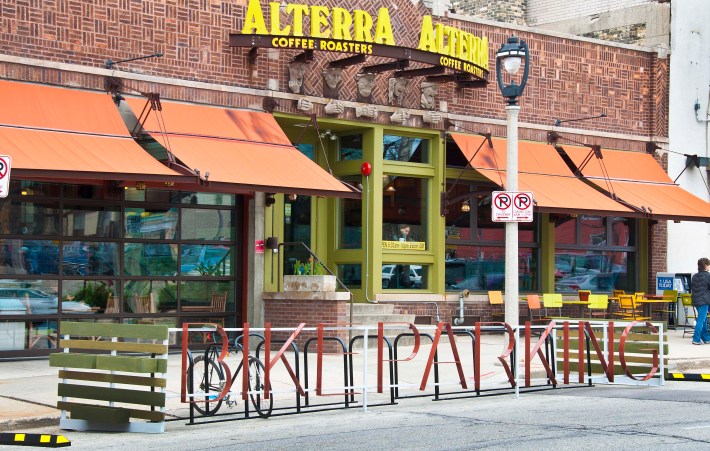
Bike corrals, meet street seats
One needn't look to the Midwest or across the country for examples. New York's own Street Seats program provides one right here at home. The program turns curbside spaces into places for people "to create an attractive setting for eating, reading, working, meeting a friend or taking a rest." And while it shares many similarities with the city's bike corral program—including the need for a local maintenance partner and site inspection by DOT—the city does allow businesses and community groups to design and build their own custom Street Seats so long as they comply with DOT design guidelines and engineering standards. Whether a business or organization chooses a custom design or one of DOT's standard designs, it bears the cost of construction and installation. DOT simply provides "operational elements, such as signage, wheel stop bars, striping on the parking lane, and/or temporary plastic bollards." Why not do the same with bike corrals?
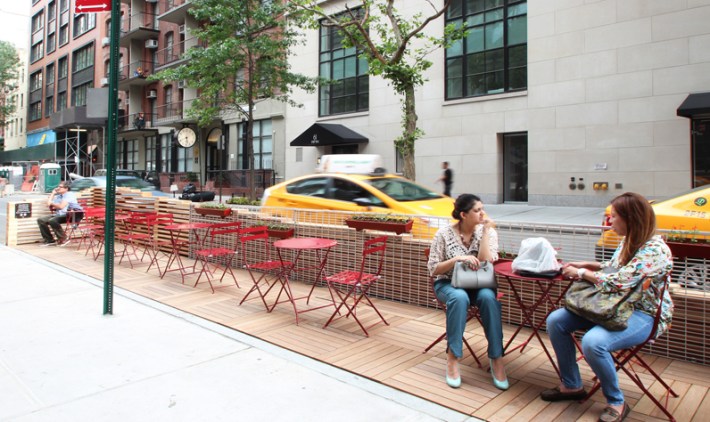
Obviously, allowing private businesses, community groups and property owners to pay for their own bike parking raises equity concerns. Would wealthy neighborhoods be dotted with conveniently placed bike corrals but low-income neighborhoods go wanting? Thankfully, this loosening of requirements could help, not hinder the pace of bike corral installation as it would free up DOT to focus its bike corral installation efforts on places where private funding is less available.
When all else fails, use paint
In many busy commercial areas, e-bikes and other delivery cycles clutter sidewalks. There's no reason for this, and the fact that bike parking is often located on sidewalks leads to people riding their bikes there, something that frequently inflames tensions between cyclists and pedestrians. The solution is easy: park e-bikes and delivery cycles on the street, no racks or other hardware necessary.
Working with local businesses, DOT could devote on-street space to bicycles with no more than paint. For restaurants where delivery cycles tend to not really come out until the evening, such spaces could convert to metered car parking during the daytime. And any fears of painted spots being hijacked by placarded vehicles could be alleviated by allowing restaurants to set out traffic cones or temporary barriers during business hours.
Painted parking spots are increasingly common in cities trying to cope with the deluge of dockless bikes and e-scooters, especially on sidewalks. They're also an established part of the bike-parking toolkit in places like the Netherlands and Denmark. And where on-street bike corrals require a maintenance partner and specific site requirements due to them being fixed to the roadbed, there's no such concern with paint. If the pavement can handle a car or SUV, it can handle eight or ten delivery cycles.
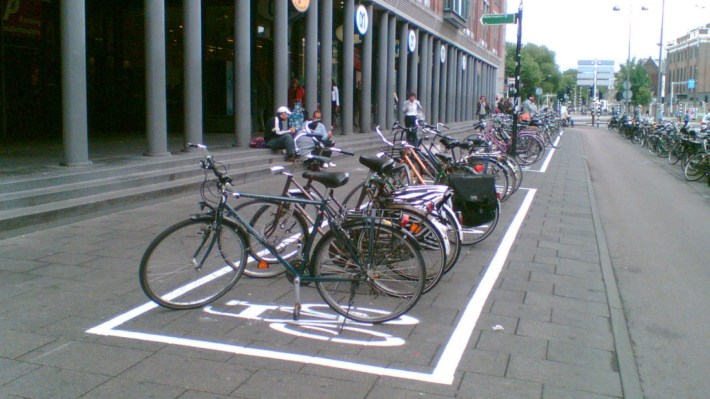
These suggestions are themselves low-hanging fruit and could be instituted tomorrow with little in the way of policy changes or infrastructure challenges. All it takes are a few easy tweaks, trust in the power of communities, and leaders who recognize the still-to-be-realized effect bike parking can have on a 21st century city.
Doug Gordon is a TV producer, writer and safe streets advocate who blogs at BrooklynSpoke.com.
